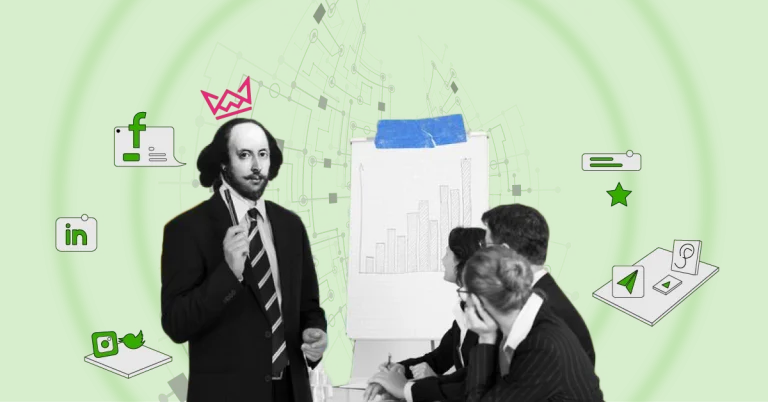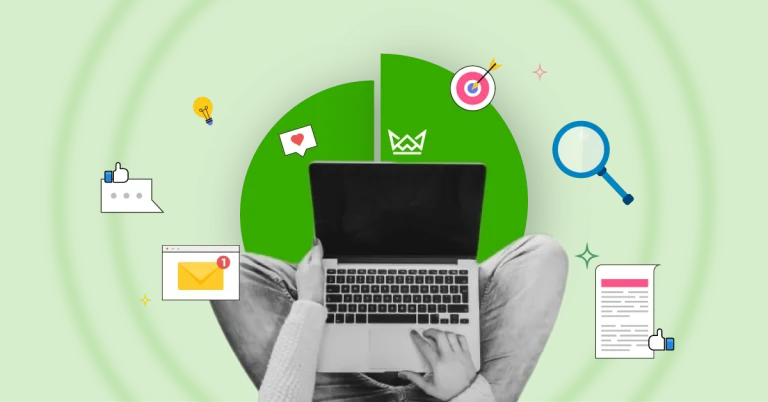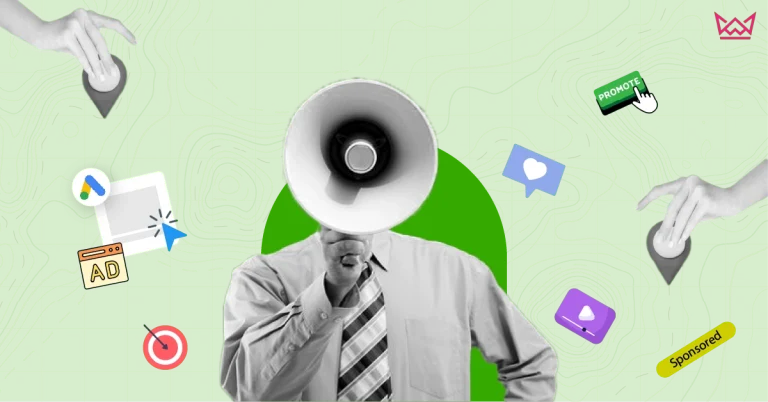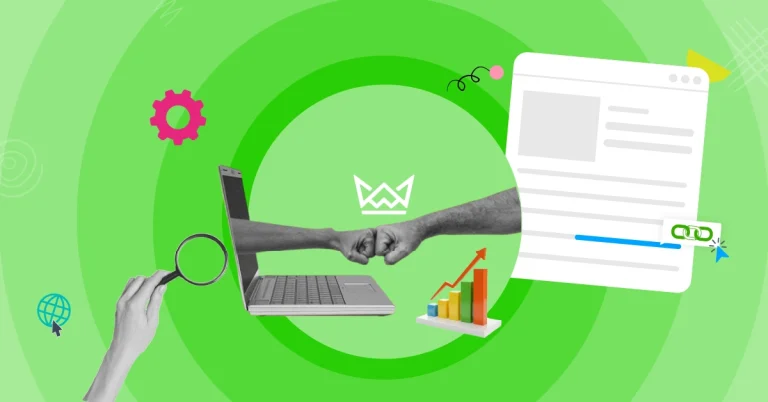B2B digital marketing isn’t just a nice-to-have—it’s a must if you’re selling to other businesses in 2025. Buyers are smarter, more informed, and expect value before ever booking a demo. Cold calls and trade shows still exist, sure, but they rarely win deals on their own anymore.
This shift has pushed B2B brands to rethink how they attract, engage, and convert leads online. Whether you’re a SaaS company or a service-based B2B firm, understanding digital marketing is now non-negotiable.
In this guide, we’ll break down what B2B digital marketing means, the best B2B digital marketing strategies, how SaaS brands are doing it differently, and the benchmarks you should aim for. You’ll also get a peek at the best tools and tactics that are working right now.
What is B2B Digital Marketing?
B2B digital marketing is the process of using online channels to promote products or services to other businesses. Unlike B2C (business-to-consumer) marketing, which focuses on quick conversions and impulse buys, B2B marketing is built around logic, trust, and long decision-making cycles.
A typical B2B buyer doesn’t just scroll and swipe—they research, compare, involve teams, and justify the purchase internally. That’s why your digital presence needs to educate, persuade, and build confidence at every step.
Think of digital marketing for B2B as your always-on sales team—blog posts answering industry questions, whitepapers solving pain points, and emails warming up cold leads. Everything works together to guide a potential buyer from awareness to action.
This is where marketing digital B2B stands apart. It’s not flashy for the sake of attention—it’s strategic, targeted, and focused on building long-term value.
Why B2B Companies Need a Solid Digital Marketing Strategy
Business buyers aren’t browsing for fun—they’re solving problems. But before they ever speak to a sales rep, they’ve already done their research, read multiple blogs, downloaded a whitepaper, and maybe even compared you with competitors.
A strong B2B digital marketing strategy ensures you’re part of that journey, not just another forgotten vendor in the search results.
Here’s why having a strategy matters:
- Buyers start online: Around 70% of the B2B buyer’s journey is completed before they reach out to sales. If your content isn’t visible during that time, you’re not even in the race.
- Multi-layered decision making: B2B purchases often require approvals from multiple departments. Your digital strategy needs to speak to technical teams, executives, and budget holders alike.
- Sales cycles are longer: It could take weeks or months to close a deal. Regular touchpoints through email, retargeting ads, and thought leadership keep you top-of-mind.
- Trust and credibility win: Case studies, testimonials, and insightful blogs build confidence. B2B buyers want partners, not pushy sellers.
- Data fuels growth: Every digital campaign gives you insights—what’s working, what’s not, and where your best leads are coming from.
With marketing digital B2B, you’re not just casting a wide net—you’re fishing with precision. Whether you’re a software provider or a manufacturing solution expert, your digital marketing strategy can be the difference between a cold lead and a closed deal.
Key B2B Digital Marketing Strategies That Deliver Results
A successful B2B digital marketing strategy isn’t about quick wins—it’s a carefully planned system that moves prospects through a longer, more complex sales funnel. Every channel, campaign, and piece of content should speak to real business problems and guide decision-makers toward trust and action.
Let’s dive into the top-performing B2B digital marketing strategies used in 2025
1. Content Marketing That Educates and Converts
In B2B, content is often the first handshake. Buyers don’t want fluff—they want answers, clarity, and proof that you know what you’re doing. That’s why content marketing sits at the core of most B2B campaigns.
Key actions:
- Create helpful blog content that addresses pain points across each stage of the buyer journey—awareness, consideration, and decision.
- Publish whitepapers and eBooks to provide deeper value in exchange for emails or contact info.
- Develop case studies and success stories to showcase real-world outcomes with actual clients.
- Use video snippets and infographics to simplify complex solutions and increase engagement.
Great content does more than educate—it qualifies leads and builds long-term credibility.

2. SEO to Get Found by the Right Buyers
SEO isn’t just for B2C anymore. It’s a critical part of digital marketing for B2B because 90% of business decision-makers search online before speaking to vendors. SEO ensures you’re not just creating content—but making sure it’s discoverable.
Key actions:
- Target long-tail keywords that reflect how real B2B buyers search (“best CRM for SaaS startups” or “ISO compliance software for manufacturers”).
- Build content clusters around themes relevant to your product, like “compliance management” or “workflow automation.”
- Fix technical SEO issues—fast load speeds, mobile optimization, clean URLs, and schema markup.
- Earn backlinks from trusted B2B publications to build authority and trust with search engines.
Done right, SEO brings in consistent, high-intent traffic that converts over time.
3. LinkedIn and Social Media for B2B Brands
Social media may not close deals directly, but it’s often where the buying journey starts. Especially on LinkedIn, B2B decision-makers are looking for insights, connections, and recommendations—often before they ever visit your site.
Key actions:
- Use LinkedIn Ads to target exact job titles, company sizes, and industries with sponsored posts or lead gen forms.
- Share original insights from your team, not just company updates. People engage with people, not logos.
- Post consistently on X (Twitter), YouTube, and even Instagram to humanize your brand and support top-of-funnel awareness.
- Engage in conversations inside niche communities or industry groups to build thought leadership and trust.
Social selling is real—and the relationships you build online often warm up cold leads before sales ever steps in.
4. Email Marketing for Lead Nurturing
Email may be old, but it’s far from dead—especially in B2B. When done right, it becomes your best tool for nurturing leads over weeks or months without feeling pushy.
Key actions:
- Segment your list based on industry, job role, and lead behavior for more personalized messaging.
- Create nurturing sequences—a series of helpful emails that educate, provide value, and lead the recipient to a CTA (demo, meeting, trial).
- Send newsletters packed with industry insights, trends, and useful tools—less “sales pitch,” more “you’ll want to read this.”
- Automate follow-ups based on user actions—downloads, website visits, or webinar sign-ups.
Email builds familiarity and turns lukewarm interest into pipeline-ready opportunities.
5. Paid Ads That Capture Intent and Demand
Organic reach takes time. Paid campaigns help you get in front of the right audience faster—especially when your SEO or email list is still growing.
Key actions:
- Run Google Search Ads targeting keywords with high purchase intent (like “pricing,” “demo,” “platform”).
- Use remarketing ads to bring back visitors who didn’t convert—often with a relevant lead magnet or offer.
- Promote case studies, tools, or webinars on LinkedIn, Facebook, and YouTube to generate high-quality leads.
- Test different creatives and formats—some audiences respond better to carousel posts, others to video or interactive content.
Smart paid campaigns can fast-track results—especially if they’re supported by great landing pages and follow-up flows.
6. Webinars and Virtual Events That Build Authority
Nothing builds authority faster than teaching your audience something useful in real time. Webinars are still one of the most powerful digital marketing techniques for B2B—especially for high-ticket or complex solutions.
Key actions:
- Host webinars around pain points, solutions, or case studies that matter to your target accounts.
- Invite industry experts or client voices to make the session more credible and engaging.
- Collect leads pre-event and follow up post-event with tailored emails, content, and meeting invites.
- Record the sessions and reuse them as gated content, blog recaps, or email nurturing assets.
Webinars create space for trust to form, and that trust leads to a pipeline.
Together, these strategies form the building blocks of any winning marketing digital b2b plan. What sets great B2B marketing apart is consistency, personalization, and data-backed decision-making at every stage.
B2B SaaS Digital Marketing – What’s Different?
Marketing for a B2B SaaS company is a whole different game. You’re not just selling a product—you’re selling an experience, often one that’s intangible, constantly evolving, and tied to monthly renewals. That means your B2B SaaS digital marketing needs to go beyond brand awareness or lead generation—it has to drive adoption, retention, and expansion.
Unlike traditional B2B models where deals end after a sale, SaaS is ongoing. Your marketing has to prove value every step of the way. Here’s how SaaS companies tailor their digital marketing strategies for B2B growth.
1. Product-Led Content is the Foundation
You can’t rely solely on benefits and features. B2B SaaS buyers want to see your product in action.
What works:
- Tutorial videos and how-to blogs that show real use cases.
- Comparison pages that highlight how your solution stacks up against alternatives.
- Feature deep-dives that speak directly to technical buyers or power users.
You’re not just generating leads—you’re onboarding, training, and enabling through your content.
2. Free Trials and Demos Drive Acquisition
With most SaaS platforms offering self-service signups or demos, your conversion path should be seamless.
What works:
- Free trials with no credit card—remove friction and let the product speak for itself.
- On-demand product tours with interactive walkthroughs.
- Chatbots or guided flows that help users experience value faster.
Marketing here isn’t just about acquisition—it’s about product activation.
3. Retention Marketing is as Critical as Acquisition
Churn is the silent killer in SaaS. Your digital marketing should also focus on keeping existing users engaged.
What works:
- Behavior-triggered emails that guide users back to underused features.
- Webinars for advanced training to help teams get more value.
- Customer success stories that reinforce value and ROI.
A happy, educated customer is more likely to renew—and upgrade.
4. ABM and Intent Data for Enterprise Deals
B2B SaaS companies often sell to both startups and enterprises. For larger accounts, personalized outreach is key.
What works:
- Account-Based Marketing (ABM) campaigns that target specific companies with tailored messaging.
- Intent data tools to identify buying signals even before a form is filled.
- LinkedIn outreach and sponsored content for C-level decision-makers.
The higher the deal size, the more personalized your digital touchpoints need to be.
5. Multi-Channel Funnels are Essential
A single-channel strategy doesn’t cut it in SaaS. Buyers bounce between your blog, pricing page, comparison tools, and reviews before deciding.
What works:
- Integrate your messaging across SEO, paid ads, email, and LinkedIn.
- Use retargeting to bring back high-intent users with personalized offers.
- Track attribution accurately to understand what truly drives conversions.
Your strategy should create a cohesive, connected journey—not isolated campaigns.
In short, B2B SaaS digital marketing is as much about customer success as it is about lead gen. You’re selling a solution that must continuously deliver value—and your marketing should reflect that from day one.
B2B Digital Marketing Benchmarks to Track in 2025
You can run the best campaigns in the world, but if you’re not measuring the right things, you’re flying blind. Benchmarks help you understand how your digital marketing is performing compared to industry standards—and more importantly, how to improve.
Tracking the right B2B digital marketing benchmarks keeps your team aligned, your budget focused, and your goals realistic.
1. Cost Per Lead (CPL)
This tells you how efficiently you’re generating leads.
What to track:
- Average CPL by channel (e.g., LinkedIn Ads vs. SEO vs. email)
- CPL for qualified leads (MQLs or SQLs, not just form submissions)
- Changes in CPL over time as you optimize campaigns
Benchmark: $150–$350 is common in B2B, but can go higher for SaaS or niche industries.
2. Email Performance Rates
Emails are still a top performer for B2B, but only if they’re getting opened and clicked.
What to track:
- Open rate (measures subject line effectiveness)
- Click-through rate (CTR) for content or CTAs
- Unsubscribe and bounce rates to monitor quality
Benchmark:
- Open rates: 18%–25%
- CTR: 2.5%–5%
3. Website Conversion Rate
This shows how well your site turns traffic into leads or customers
What to track:
- % of visitors who fill out forms, book demos, or download resources
- High-converting pages vs. underperforming ones
- Exit rates on landing pages
Benchmark: 1.5%–3% is a healthy average for B2B websites
4. Organic Traffic Growth
SEO is a long-term play, but it pays off with compounding results.
What to track:
- Month-over-month or quarter-over-quarter organic traffic
- Number of keywords ranking in the top 10
- Traffic to high-intent pages (e.g., pricing, demo, solution pages)
Benchmark: 10%–20% organic growth per quarter is realistic for early-stage brands.
5. Marketing-Sourced Revenue
Marketing’s job isn’t just traffic—it’s pipeline and revenue.
What to track:
- % of revenue that originated from marketing activities
- Lead-to-customer conversion rate
- Pipeline velocity (how quickly leads become deals)
Benchmark: Many B2B SaaS companies aim for 30%–50% of revenue sourced by marketing.
6. Lead Quality Scores
High lead volume is meaningless if sales can’t close them.
What to track:
- % of leads that meet your ideal customer profile (ICP)
- Sales team feedback on MQLs
- Lead scoring based on engagement and fit
Benchmark: Ideally, 50%+ of marketing leads should convert to sales conversations.
7. Ad Performance Metrics
If you’re investing in paid media, track more than just clicks.
What to track:
- Cost per click (CPC)
- Conversion rate from ad traffic
- Return on ad spend (ROAS)
Benchmark: ROAS of 3x+ is solid for B2B; lower in awareness-stage campaigns.
These benchmarks don’t exist to box you in—they give you context. The real value is in using them to set better goals, spot weaknesses, and prioritize what’s working in your digital marketing b2b efforts.
Top Tools for B2B Digital Marketing Success
You can have the best strategy, content, and messaging—but without the right tools, execution becomes slow, scattered, and inconsistent. The right digital tools bring structure to your campaigns, make data actionable, and help teams move faster.
Let’s look at the essential tools B2B marketers rely on to drive results across the funnel—from awareness to revenue.
1. HubSpot – For CRM, Automation & Lead Nurturing
HubSpot is the go-to platform for many B2B marketers because it brings everything under one roof—CRM, email marketing, workflows, landing pages, and analytics.
Why it works:
- Aligns marketing and sales teams on a single platform.
- Automates lead nurturing and follow-ups.
- Tracks user journeys and scores leads based on engagement.
Perfect for: Mid-to-large B2B teams that want scalability without tech headaches.
2. Semrush or Ahrefs – For SEO and Competitor Analysis
Ranking on Google isn’t guesswork anymore. Tools like Semrush and Ahrefs give you a clear view of what your audience is searching, how your competitors rank, and where your SEO gaps lie.
Why it works:
- Finds keyword opportunities based on buyer intent.
- Audits your site for SEO issues like broken links or poor load times.
- Tracks backlinks and domain authority over time.
Perfect for: Driving organic traffic with a long-term content strategy.
3. LinkedIn Campaign Manager – For Precision Targeting
When it comes to digital marketing for B2B, LinkedIn is the top ad platform. Campaign Manager helps you target professionals by job title, industry, company size, and more.
Why it works:
- Advanced B2B targeting options not available on other platforms.
- Built-in lead generation forms to reduce drop-offs.
- Great for ABM (Account-Based Marketing) campaigns.
Perfect for: Generating qualified leads and brand awareness in niche industries.
4. Google Analytics 4 (GA4) – For Website Performance Tracking
GA4 helps you understand how users interact with your website—what pages they visit, where they drop off, and how traffic sources perform.
Why it works:
- Real-time traffic and event tracking.
- Conversion paths and funnel analysis.
- Integrates with Google Ads, Search Console, and CRMs.
Perfect for: Optimizing website performance and improving conversion rates.
5. Clearbit or ZoomInfo – For Lead Enrichment
Not all form fills are equal. These tools enrich your lead data with firmographic insights—like company size, revenue, location, and tech stack—so your sales team spends less time researching.
Why it works:
- Instantly qualifies leads using enrichment data.
- Helps you personalize outreach based on role or industry.
- Integrates with most CRMs and email platforms.
Perfect for: Shortening the sales cycle with more context and better targeting.
6. Hotjar or Microsoft Clarity – For Behavior Analysis
Want to know what’s really happening on your website? These tools offer heatmaps, session recordings, and scroll tracking.
Why it works:
- See where users click, scroll, or drop off.
- Identify UX bottlenecks on landing pages.
- Improve design and navigation based on real behavior.
Perfect for: Increasing conversions through design and copy improvements.
Together, these tools act as your digital marketing B2B toolkit—empowering you to track the right data, automate your workflows, and continuously improve results. You don’t need all of them on day one, but using a few of the right ones can give your campaigns a serious edge.
Best Practices and Pitfalls to Avoid
A strong B2B digital marketing strategy isn’t just about what you do—it’s also about what you don’t do. Many marketers fall into the trap of chasing shiny tactics without fixing the fundamentals. On the flip side, those who consistently follow a few best practices tend to build marketing engines that grow quietly—and powerfully.
Here’s what works (and what to avoid) when running digital marketing for B2B campaigns.
Best Practices and Pitfalls to Avoid
1. Focus on educating—not just selling
B2B buyers don’t respond well to pushy sales talk. Give them value first: insights, frameworks, examples. That earns attention and trust.
2. Align sales and marketing teams
Your best marketing efforts will fall flat if sales doesn’t know how to handle leads. Regular syncs, shared dashboards, and feedback loops help close that gap.
3. Personalize your outreach
Use dynamic content, segmented emails, and role-specific landing pages. The more relevant your message, the higher the conversion.
4. Invest in technical SEO and site speed
Even the best content won’t rank if your website is slow, broken, or missing basic SEO structure. Fix that foundation early.
5. Use intent data to prioritize leads
Not all leads are equal. Use tools that show who’s actively researching your category and target them with timely outreach.
6. Build remarketing flows across multiple channels
Follow your visitors across LinkedIn, YouTube, and email. Use different formats—case studies, offers, testimonials—to pull them back in.
7. Regularly audit your funnels
What worked last year may be underperforming now. Review your landing pages, ad copy, and email sequences quarterly.
Common Pitfalls That Hurt Performance
1. Treating B2B like B2C
Impulse buying doesn’t exist in B2B. You need more than flash sales and hashtags—your content must speak to logic, ROI, and long-term value.
2. Ignoring mobile UX
Decision-makers do scroll through emails and websites on mobile. If your CTA buttons are hidden or content is unreadable, that’s lost revenue.
3. Over-relying on gated content
Gating every resource frustrates users. Offer a mix of open-access and lead-gen content to build trust before asking for data.
4. Tracking the wrong metrics
Vanity metrics like impressions or email sends mean little without real conversions. Focus on lead quality, funnel velocity, and marketing-sourced revenue.
5. Copy-pasting competitor tactics
What works for one brand may flop for another. Test your messaging, voice, and offers before scaling any tactic.
6. Ignoring mid-funnel content
Top-of-funnel blogs are great, but don’t forget middle-of-funnel assets like comparison guides, solution pages, or pricing breakdowns.
The takeaway? B2B success depends on consistency, clarity, and customer-first thinking. Avoid shortcuts. Keep improving. And treat every campaign like a conversation—not a sales pitch.
Conclusion – Building a Future-Ready B2B Marketing Digital Strategy
B2B buyers have changed—and so must your marketing. Cold emails, generic messaging, and disconnected campaigns just don’t work anymore. What does? A focused, measurable, and human-first approach that solves problems and builds trust at every stage of the funnel.
Whether you’re creating long-form blogs, running LinkedIn ads, or hosting product webinars, the goal is the same: stay helpful, stay visible, and stay relevant. Your B2B digital marketing strategy should be less about tactics and more about delivering consistent value—through great content, seamless experiences, and data-informed decisions.
As channels evolve and benchmarks shift, what stays constant is the need for clear messaging, personalized engagement, and collaboration across teams. If you’re in B2B SaaS, professional services, or manufacturing—it doesn’t matter. The winning playbook always starts with knowing your buyer and building everything else around that.
In short, marketing digital para B2B is no longer optional—it’s your competitive advantage.








Leave a Comment